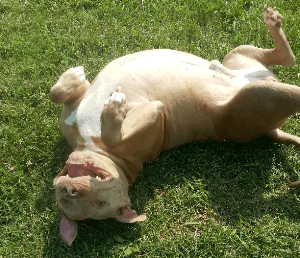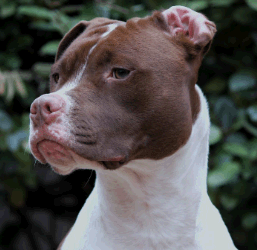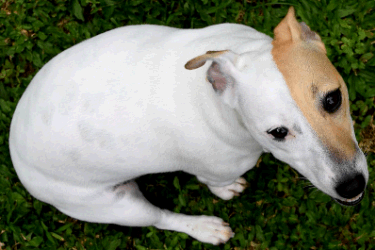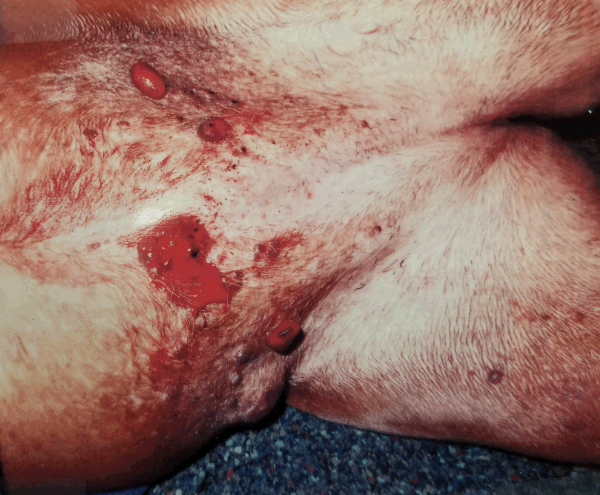|
ACTINIC (SOLAR) DERMATITIS

|
Most of us know that sun exposure can be damaging to the skin. We get wrinkles, sunburn, and even sun-induced skin cancers. It turns out that dogs have similar issues.
Sunbathing is Fun but Not so Healthy
Pets like to sunbathe just like people do. Many like to lie happily on their backs and soak up the damaging UVB light. UVB light is pretty unpleasant stuff. For one thing, UVB light induces the inflammatory response of skin cells, damages the immune cells of the skin, and induces mutations in the DNA of skin cells. At first, the skin becomes pimply and red but then plaques of thick skin develop and spread. Skin cancer can form and not all forms of skin cancer stay confined to the skin.
|
 (Photocredit: Morguefile.com) (Photocredit: Morguefile.com) |
|
Dogs At Risk
For most of the time a good fur coat is all the protection a dog needs to avoid damage from the sun. After all, protection from the environment is what fur is all about. There are two problems, however: the tummy (which is sparsely furred in most dogs), and short white fur (which sunlight readily penetrates). This puts the pit bull terrier at special risk but any dog with similar hair length (greyhound, pointer, Dalmatian etc.) can have a problem with too much sun exposure, on the tummy or otherwise.
|
 (Photocredit: Morguefile.com) (Photocredit: Morguefile.com) |
 (Photocredit: Unsplash.com) (Photocredit: Unsplash.com) |
 (Photocredit: Unsplash.com) (Photocredit: Unsplash.com) |
What Does it Look Like?
The white fur becomes patchy and the skin below becomes red and irritated. In contrast, if there are adjacent patches of dark fur, the coat is lush and normal with no patchy hair loss and the skin underneath is uninflamed. Passing one’s fingers across the fur from white to colored will yield a dramatic difference in skin texture as the colored fur is protective against the sun. Infection (usually a pimply red rash) is common in many skin conditions including this one so sometimes a course of antibiotics can make the underlying sun-induced situation more clear. Biopsy of sun-induced skin damage is very characteristic and should be able to settle any questions.
Treatment of Actinic Dermatitis
As long as skin cancer has not actually cropped up, treatment focuses on inflammation and reducing sun exposure.
ANTIBIOTICS: Most actinic dermatitis cases have a hefty secondary Staphylococcus infection and need a couple of weeks of antibiotics.
TOPICAL STEROIDS: If there is a lot of inflammation and discomfort in the skin, a week or so of topical steroids can relieve this. Be sure to use a product made for animals as human products may not have been made with the expectation that they will be licked.
VITAMIN A: Protocols using daily Vitamin A have been shown to reduce the development of skin cancer and mitigate damage from the sun. Your veterinarian can tell you what to get.
PENTOXIPHYLLINE: This medication can improve circulation to the skin thus assisting with perfusion and healing.

REDUCE SUN EXPOSURE!
- If possible, keep the pet indoors during the hours of 11AM-2PM.
- Beware of outdoor areas featuring a lot of white concrete. This type of flooring is highly reflective of sunlight and will expose a tummy to sunlight even without sunbathing.
- Sun Screen on the skin but be careful of human products as they have irritating scents and potential for toxicity (zinc oxide can be toxic if licked). For dogs, Epi-Pet® can be purchased at many outlets. Dermoscent SunFree lotion is made for both dogs and cats..
- SunSuits and T-shirts. A T-shirt is better than nothing. Leg holes can be cut out so that the tummy and back are well covered. This will unfortunately leave the legs vulnerable. Surfing dogs have used canine sunsuits for years, protecting the whole body. Unfortunately, most of the companies that make these are in Australia but K9TopCoat.com is an American company that sells appropriate protective dog clothing.

PRE-CANCER AND CANCER
|
If sun-induced dermatitis does not seem to respond or if actual growths or “blood blisters” emerge, biopsy is probably in order. Biopsy will identify the presence of sun-induced tumors as well as skin in a precancerous state. Any tumors should be removed as soon as possible. Any skin in a precancerous state needs special attention.
Tumors: The sun can induce squamous cell carcinoma or hemangiosarcoma in the skin. Surgery is often curative especially if performed early but the problem is that multiple areas of tumor can arise and in an area like the belly, there is only so much skin that can be removed. Your veterinarian will guide you but many dogs need to come in monthly as new skin tumors pop up. Small tumors can be removed with local anesthetic. Your veterinarian will determine your best protocol. It may be necessary to consult a cancer specialist (oncologist).
Precancer: One should remove growths where ever possible and implement some sort of prevention for the rest of the skin which is undoubtedly in a precancerous state. Obviously, the treatments listed above should be employed but there are some extra steps that may help as well as.
|

Sun-induced hemagiosarcoma lesions bleed readily
and look like "blood blisters
(original graphic by marvistavet.com) |
NON-STEROIDAL ANTI-INFLAMMATORIES: These not only help with pain but can also inhibit sun-induced cancers. Never use a human product in your pet without specific instructions from your veterinarian as many of human NSAIDs are toxic to animals
IMIQUAMOD: This is a topical ointment with anti-tumor effects. It can be expensive for a larger dog but an ointment is able to cover a large expense of sun-exposed tummy. This medication is not appropriate for licking so special wraps may be needed if it is used.

If you have a light-coated short-haired dog, be careful of sun exposure because the fur is likely not enough protection alone. Any “blood blisters” on the skin, especially the tummy should be seen by the veterinarian. Time in the sun should be fun for everyone, including the family dog.

Page posted: 12/5/2019
Page last updated: 7/1/2024
|